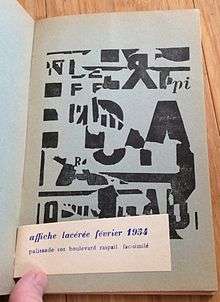Hypergraphy

Hypergraphy, also called hypergraphics and metagraphics, is a method, central to the Lettrist movement of the 1950s, which encompasses a synthesis of writing and other modalities.[1] Isidore Isou, the founder of Lettrism, said that "Metagraphics or post-writing, encompassing all the means of ideographic, lexical and phonetic notation, supplements the means of expression based on sound by adding a specifically plastic dimension, a visual facet which is irreducible and escapes oral labelling..."[2]
Hypergraphy merges poetry (text) with more visual (graphic) ways of communication such as painting, illustration or signs. The technique was first known as 'metagraphics', but later became known as 'hypergraphics'. Maurice Lemaître, a Lettrist theorist, defined it as communicating through the union of various forms of communication, as an "ensemble of signs capable of transmitting the reality served by the consciousness more exactly than all the former fragmentary and partial practices (phonetic alphabets, algebra, geometry, painting, music, and so forth)."[3]
The technique was used in Lettrist painting and cinema, in which letters were drawn directly onto the film. As the Lettrists became more experimental in their use of media, the technique was applied more to everyday life in critiquing urbanism and architecture in the Lettrist field of psychogeography.
See also
References
- ↑ Isou, Isidore (1964). "The Force Fields of Letterist Painting". 'Les Champs de Force de la Peinture Lettriste. Paris: Avant-Garde.
If one places an abstract composition—which is simply a fragmentary purification of the former object—in (or alongside) a figurative structure, this second composition digests the first one—transformed into a decorative motif—and then the whole work becomes figurative. However if one places a letterist notation on (or beside) a realist "form," it is the first one which assimilates the second to change the whole thing into a work of hypergraphics or super-writing.
- ↑ Isou, Isidore (1964). Les Champs de Force de la Peinture Lettriste. Paris: Avant-Garde. Excerpt found at Selections from the Manifestosof Isidore Isou, ed. and trans.by David W. Seaman
- ↑ Foster, Stephen C. (2005). "Lettrism: A Point of Views". In Ford, Simon. The Situationist International. London: Black Dog Publishing. p. 20.
Further reading
- Curtay, Jean-Paul: Letterism and Hypergraphics: The Unknown Avant-Garde 1945-1985, Franklin Furnace, New York, 1985
- Bohn, From Hieroglyphics to Hypergraphics" in Experimental - Visual - Concrete Avant-Garde Poetry Since the 1960s, 1996
- Acquaviva, Frédéric & Buzatu, Simona (eds): Isidore Isou: Hypergraphic Novels – 1950-1984, Romanian Cultural Institute, Stockholm, 2012.